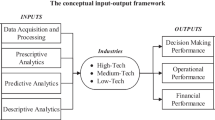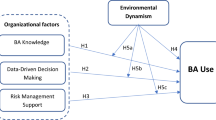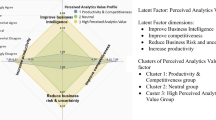Abstract
The adoption of business analytics (BA) in emerging countries, such as India is growing significantly over the last few years. However, the research on technological capabilities and BA adoption is scant in the context of emerging countries. There is a need to understand the capabilities needed for managing BA technology in organizations in India. The purpose of this study is to investigate the factors influencing BA adoption in firms in India. The study is based on the TOE (technological, organizational, environmental) framework in combination with perceived benefits of BA adoption. The study uses thematic content analysis of the primary data collected through semi-structured interviews from senior management personnel’s in organizations. Some of the major factors validated from this study are perceived benefits, organizational data environment, technology assets, and competitive pressure. The study finds data quality and human resources competency with BA skills as specific challenges for organizations in India. The findings of this study can be useful for the organizations to develop their BA practices to differentiate from the competition. This study contributes to the existing knowledge on BA adoption and would facilitate future researches on higher level BA capabilities on the elements of management of technology (MoT) framework.



Similar content being viewed by others
References
Alshamaila, Y., Papagiannidis, S., & Li, F. (2013). Cloud computing adoption by SMEs in the north east of England: A multi-perspective framework. Journal of Enterprise Information Management, 26(3), 250–275.
Analytics Report. (2018). https://peepalconsulting.com/wp-content/uploads/2018/06/Analytics-Report-2018.pdf. Accessed 20 Nov 2019.
Barney, J. B. (2001). Resource-based theories of competitive advantage: A ten-year retrospective on the resource-based view. Journal of Management, 27(6), 643–650.
Braganza, A., Brooks, L., Nepelski, D., Ali, M., & Moro, R. (2017). Resource management in big data initiatives: Processes and dynamic capabilities. Journal of Business Research, 70, 328–337.
Braun, V., & Clarke, V. (2006). Using thematic analysis in psychology. Qualitative research in psychology, 3(2), 77–101.
Chen, L., & Nath, R. (2018). Business analytics maturity of firms: an examination of the relationships between managerial perception of IT, business analytics maturity and success. Information Systems Management, 35(1), 62–77.
Chen, D. Q., Preston, D. S., & Swink, M. (2015). How the use of big data analytics affects value creation in supply chain management. Journal of Management Information Systems, 32(4), 4–39.
Chwelos, P., Benbasat, I., & Dexter, A. S. (2001). Empirical test of an EDI adoption model. Information Systems Research, 12(3), 304–321.
Coghlan, T., Diehl, G., Karson, E., Liberatore, M., Luo, W., Nydick, R., et al. (2010). The current state of analytics in the corporation: The view from industry leaders. International Journal of Business Intelligence Research (IJBIR), 1(2), 1–8.
Côrte-Real, N., Oliveira, T., & Ruivo, P. (2017). Assessing business value of big data analytics in European firms. Journal of Business Research, 70, 379–390.
Dangayach, G. S., Pathak, S. C., & Sharma, A. D. (2006). Advanced manufacturing technology: A way of improving technological competitiveness. International Journal of Global Business and Competitiveness, 2(1), 1–8.
Davenport, T. H. (2006). Competing on analytics. Harvard Business Review, 84(1), 98.
Davis, F. D. (1986). A technology acceptance model for empirically testing new end-user information systems: Theory and results. Doctoral dissertation, Sloan School of Management, Massachusetts Institute of Technology, Cambridge, MA.
Dean, J. W., Jr., & Sharfman, M. P. (1996). Does decision process matter? A study of strategic decision-making effectiveness. Academy of Management Journal, 39(2), 368–392. https://doi.org/10.5465/256784.
Delen, D., & Ram, S. (2018). Research challenges and opportunities in business analytics. Journal of Business Analytics, 1(1), 2–12. https://doi.org/10.1080/2573234X.2018.1507324.
Dubey, R., Gunasekaran, A., Childe, S. J., Wamba, S. F., & Papadopoulos, T. (2016). The impact of big data on world-class sustainable manufacturing. The International Journal of Advanced Manufacturing Technology, 84(1–4), 631–645.
Dutta, D., & Bose, I. (2015). Managing a big data project: the case of ramco cements limited. International Journal of Production Economics, 165, 293–306.
Erevelles, S., Fukawa, N., & Swayne, L. (2016). Big Data consumer analytics and the transformation of marketing. Journal of Business Research, 69(2), 897–904.
Esteves, J., & Curto, J. (2013). A risk and benefits behavioral model to assess intentions to adopt big data: Proceedings of the 10th International Conference on Intellectual Capital, Knowledge Management and Organisational Learning: ICICKM 2013.
EY says Indian firms are more analytics savvy. (2017). https://economictimes.indiatimes.com/tech/ites/ey-says-indian-firms-are-more-analytics-savvy/articleshow/59249212.cms.
Fielding, N. G. (2012). Triangulation and mixed methods designs: Data integration with new research technologies. Journal of Mixed Methods Research, 6(2), 124–136.
Franklin, C. S., Cody, P. A., & Ballan, M. (2010). The handbook of social work research methods B. Thyer. Thousand Oaks: SAGE Publishing.
Gaardboe, R., & Svarre, T. (2018). business intelligence success factors: A literature review. Journal of Information Technology Management, 29(1), 1–15.
Gandomi, A., & Haider, M. (2015). Beyond the hype: Big data concepts, methods, and analytics. International Journal of Information Management, 35(2), 137–144.
Gangwar, H. (2018). Understanding the determinants of big data adoption in India: An analysis of the manufacturing and services sectors. Information Resources Management Journal, 31(4), 1–22.
Gangwar, H., & Date, H. (2016). Critical factors of cloud computing adoption in organizations: An empirical study. Global Business Review, 17(4), 886–904.
Gardas, B. B., Mangla, S. K., Raut, R. D., Narkhede, B., & Luthra, S. (2019). Green talent management to unlock sustainability in the oil and gas sector. Journal of Cleaner Production, 229, 850–862.
Ghasemaghaei, M., Ebrahimi, S., & Hassanein, K. (2018). Data analytics competency for improving firm decision making performance. The Journal of Strategic Information Systems, 27(1), 101–113.
Goode, S., & Stevens, K. (2000). An analysis of the business characteristics of adopters and non-adopters of world wide web technology. Information Technology and Management, 1(1–2), 129–154.
Hsu, P. F., Ray, S., & Li-Hsieh, Y. Y. (2014). Examining cloud computing adoption intention, pricing mechanism, and deployment model. International Journal of Information Management, 34(4), 474–488.
Iacovou, C. L., Benbasat, I., & Dexter, A. S. (1995). Electronic data interchange and small organizations: Adoption and impact of technology. MIS Quarterly, 19, 465–485.
Khalil, T. (2000). Management of Technology. The Key to Competitiveness and Wealth Creation. Boston: McGraw-Hill.
King, N. (2004). Using templates in the thematic analysis of text. In C. Cassell & G. Symon (Eds.), Essential guide to qualitative methods in organizational research (pp. 257–270). London: Sage.
Kiron, D., & Shockley, R. (2011). Creating business value with analytics. MIT Sloan Management Review, 53(1), 57–63.
Klatt, T., Schlaefke, M., & Moeller, K. (2011). Integrating business analytics into strategic planning for better performance. Journal of Business Strategy, 32(6), 30–39.
Kuan, K. K., & Chau, P. Y. (2001). A perception-based model for EDI adoption in small businesses using a technology–organization–environment framework. Information and Management, 38(8), 507–521.
Kwon, O., Lee, N., & Shin, B. (2014). Data quality management, data usage experience and acquisition intention of big data analytics. International Journal of Information Management, 34(3), 387–394.
Labrinidis, A., & Jagadish, H. V. (2012). Challenges and opportunities with big data. Proceedings of the VLDB Endowment, 5(12), 2032–2033.
Lai, Y., Sun, H., & Ren, J. (2018). Understanding the determinants of big data analytics (BDA) adoption in logistics and supply chain management: An empirical investigation. International Journal of Logistics Management, 29(2), 676–703. https://doi.org/10.1108/IJLM-06-2017-0153.
Lavalle, S., Lesser, E., Shockley, R., Hopkins, M. S., & Kruschwitz, N. (2011). Big data, analytics and the path from insights to value. MIT Sloan Management Review, 52(2), 21–32.
Lim, J. H., Stratopoulos, T. C., & Wirjanto, T. S. (2011). Path dependence of dynamic information technology capability: An empirical investigation. Journal of Management Information Systems, 28(3), 45–84.
Lind, M. R., & Zmud, R. W. (1991). The influence of a convergence in understanding between technology providers and users on information technology innovativeness. Organization Science, 2(2), 195–217.
Low, C., Chen, Y., & Wu, M. (2011). Understanding the determinants of cloud computing adoption. Industrial Management and Data Systems, 111(7), 1006–1023.
Marshall, A., Mueck, S., & Shockley, R. (2015). How leading organizations use big data and analytics to innovate. Strategy & Leadership, 43(5), 32–39. https://doi.org/10.1108/SL-06-2015-0054.
Mathew, S. K. (2012). Adoption of business intelligence systems in Indian fashion retail. International Journal of Business Information Systems, 9(3), 261–277.
Miles, M. B., & Huberman, A. M. (1994). Qualitative data analysis: An expanded sourcebook. Thousand Oaks: Sage.
Momaya, K. (2001). International competitiveness: Evaluation and enhancement (1st ed.). New Delhi: Hindustan Publishing Corporation.
Momaya, K.S. (2017). Management of Technology and Innovation (MOT) for Competitiveness: Diagnosing Problems at Vonda Motors. Case Centre No. 318-0001-1. https://www.thecasecentre.org/main/products/view?id=149299. Accessed 20 May 2020.
Momaya, K. S. (2019). The past and the future of competitiveness research: A review in an emerging context of innovation and EMNEs. International Journal of Global Business and Competitiveness, 14(1), 1–10. https://doi.org/10.1007/s42943-019-00002-3.
Momaya, K., & Ajitabh, A. (2005). Technology management and competitiveness: Is there any relationship? International Journal of Technology Transfer and Commercialisation, 4(4), 518–524.
Momaya, K. S., & Lalwani, L. (2017). Systems of technological innovation: A review of research activities taking the case of nanotechnology and India. Technology Analysis and Strategic Management, 29(6), 626–641. https://doi.org/10.1080/09537325.2016.1220516.
Musawa, M. S., & Wahab, E. (2012). The adoption of electronic data interchange (EDI) technology by nigerian smes: A conceptual framework. Journal of Business Management and Economics, 3(2), 55–68.
Nam, D., Lee, J., & Lee, H. (2019). Business analytics adoption process: An innovation diffusion perspective. International Journal of Information Management, 49, 411–423.
Narwane, V. S., Raut, R. D., Gardas, B. B., Kavre, M. S., & Narkhede, B. E. (2019a). Factors affecting the adoption of cloud of things: The case study of Indian small and medium enterprises. Journal of Systems and Information Technology, 21(4), 397–418. https://doi.org/10.1108/JSIT-10-2018-0137.
Narwane, V. S., Narkhede, B. E., Gardas, B. B., & Raut, R. D. (2019b). Cloud manufacturing issues and its adoption: Past, present, and future. International Journal of Management Concepts and Philosophy, 12(2), 168–199. https://doi.org/10.1504/IJMCP.2019.099319.
Nasir, S. (2005). The development, change, and transformation of management information systems (MIS): A thematic content analysis of articles published in business and marketing journals. International journal of information management, 25(5), 442–457.
Nayak, B., Bhattacharyya, S. S., & Krishnamoorthy, B. (2019). Integrating wearable technology products and big data analytics in business strategy: A study of health insurance firms. Journal of Systems and Information Technology, 21(2), 255–275. https://doi.org/10.1108/JSIT-08-2018-0109.
Nowell, L. S., Norris, J. M., White, D. E., & Moules, N. J. (2017). Thematic analysis: Striving to meet the trustworthiness criteria. International Journal of Qualitative Methods, 16(1), 1609406917733847.
Oliveira, T., & Martins, M. F. (2011). Literature review of information technology adoption models at firm level. The Electronic Journal Information Systems Evaluation, 14(1), 110–121.
Oliveira, T., Thomas, M., & Espadanal, M. (2014). Assessing the determinants of cloud computing adoption: An analysis of the manufacturing and services sectors. Information and Management, 51(5), 497–510.
Panchal, D., & Krishnamoorthy, B. (2019). Developing an instrument for business model dimensions: exploring linkages with firm competitiveness. International Journal of Global Business and Competitiveness, 14(1), 24–41. https://doi.org/10.1007/s42943-019-00004-1.
Patton, Q. M. (1999). Qualitative evaluation and research methods (2nd ed.). London: Sage Publications Inc.
Poon, N., & Daniel, B. K. (2006). Social network and content analysis of interactions in a video-mediated virtual community: Proceedings of the Sixth International Conference on Advanced Learning Technologies (pp. 901–903).
Popovič, A., Hackney, R., Coelho, P. S., & Jaklič, J. (2012). Towards business intelligence systems success: Effects of maturity and culture on analytical decision making. Decision Support Systems, 54(1), 729–739.
Porter, M. E. (1996). What is strategy? Harvard Business Review, 74(6), 61–8078.
Premkumar, G., & Roberts, M. (1999). Adoption of new information technologies in rural small businesses. Omega, 27(4), 467–484.
Premkumar, G., Ramamurthy, K., & Nilakanta, S. (1994). Implementation of electronic data interchange: An innovation diffusion perspective. Journal of Management Information Systems, 11(2), 157–186.
Puklavec, B., Oliveira, T., & Popovič, A. (2018). Understanding the determinants of business intelligence system adoption stages. Industrial Management and Data Systems, 118(1), 236–261.
Punch, F. K. (2004). The analysis of qualitative data. London: SAGE Publications Ltd.
Raguseo, E. (2018). Big data technologies: An empirical investigation on their adoption, benefits and risks for companies. International Journal of Information Management, 38(1), 187–195.
Ramamurthy, K. R., Sen, A., & Sinha, A. P. (2008). An empirical investigation of the key determinants of data warehouse adoption. Decision Support Systems, 44(4), 817–841.
Ramanathan, R., Duan, Y., Cao, G., & Philpott, E. (2012). World academy of science, engineering and technology. Energy and Power Engineering, 69, 855.
Ramanathan, R., Philpott, E., Duan, Y., & Cao, G. (2017). Adoption of business analytics and impact on performance: a qualitative study in retail. Production Planning and Control, 28(11–12), 985–998.
Raut, R. D., Gardas, B. B., Narkhede, B. E., & Narwane, V. S. (2019). To investigate the determinants of cloud computing adoption in the manufacturing micro, small and medium enterprises: A DEMATEL-based approach. Benchmarking: An International Journal, 26(3), 990–1019. https://doi.org/10.1108/BIJ-03-2018-0060.
Rigby, D., & Bilodeau, B. (2015). Management tools and trends 2015. Boston: Bain & Company.
Rogers, E. M. (1995). Diffusion of innovations. New York: Free Press.
Rozenblum, R., Jang, Y., Zimlichman, E., Salzberg, C., Tamblyn, M., Buckeridge, D., et al. (2011). A qualitative study of Canada’s experience with the implementation of electronic health information technology. CMAJ, 183(5), E281–E288.
Sahoo, T., Banwet, D. K., & Momaya, K. (2010). Strategic technology management in practice: Dynamic SAP-LAP analysis of an auto component manufacturing firm in India. Global Journal of Flexible Systems Management, 11(1–2), 13–23. https://doi.org/10.1007/BF03396575.
Sahoo, T., Banwet, D. K., & Momaya, K. (2011). Strategic technology management practices in select auto component joint ventures in India: A case study using SAP-LAP methodology. International Journal of Engineering Management and Economics, 2(2–3), 153–174. https://doi.org/10.1504/IJEME.2011.041994.
Salian, S., Bali, A., Yugandhar, V., & Momaya, K. S. (2018). Analyzing the role of management of technology in the growth of technology ventures. In S. T. Sushil & A. Kulkarni (Eds.), Flexibility in resource management. Flexible Systems Management. Singapore: Springer. https://doi.org/10.1007/978-981-13-9640-3_1.
Santa, R., Ferrer, M., Bretherton, P., & Hyland, P. (2009). The necessary alignment between technology innovation effectiveness and operational effectiveness. Journal of Management and Organization, 15(2), 155–169.
Saunders, M., Lewis, P., & Thornhill, A. (2007). Research methods for business studies (4th ed.). Essex: Pearson Education Limited.
Schultze, U., & Avital, M. (2011). Designing interviews to generate rich data for information systems research. Information and Organization, 21(1), 1–16.
Shee, H., VanGramberg, B., & Foley, P. (2011). Capability and practices to enhance firm competitiveness under competitive intensity: A SEM approach. International Journal of Global Business and Competitiveness, 6(1), 1–13.
Shrotriya, S., Dhir, S., & Sushil. (2018). Innovation driven ecosystem for quality skill development in India. Benchmarking: An International Journal, 25(8), 2997–3020. https://doi.org/10.1108/BIJ-11-2017-0320.
Shukla, S. K., & Sushil, P. K. (2020). Generic flexibility evaluation model. In P. Suri & R. Yadav (Eds.), Transforming organizations through flexible systems management: flexible systems management. Singapore: Springer. https://doi.org/10.1007/978-981-10-4888-3_10
Sun, S., Cegielski, C. G., Jia, L., & Hall, D. J. (2018). Understanding the factors affecting the organizational adoption of big data. Journal of Computer Information Systems, 58(3), 193–203.
Sushil, S., & Garg, S. (2019). Internationalization of Tata Motors: Strategic analysis using flowing stream strategy process. International Journal of Global Business and Competitiveness, 14(1), 54–70. https://doi.org/10.1007/s42943-019-00006-z.
Tallon, P. P., & Kraemer, K. L. (2007). Fact or fiction? A sensemaking perspective on the reality behind executives' perceptions of IT business value. Journal of Management Information Systems, 24(1), 13–54.
Teece, D. J., Pisano, G., & Shuen, A. (1997). Dynamic capabilities and strategic management. Strategic Management Journal, 18(7), 509–533.
Tornatzky, L. G., & Fleischer, M. (1990). The processes of technological innovation. Lexington: Lexington Books.
US National Research Council. (1987). Management of technology the hidden competitive advantage. Washington: National Academy Press.
Venkatesh, V., Morris, M. G., Davis, G. B., & Davis, F. D. (2003). User acceptance of information technology: Toward a unified view. MIS Quarterly, 27(3), 425–478.
Verma, S., & Bhattacharyya, S. S. (2017). Perceived strategic value-based adoption of big data analytics in emerging economy: A qualitative approach for Indian firms. Journal of Enterprise Information Management, 30(3), 354–382.
Vidgen, R., Shaw, S., & Grant, D. B. (2017). Management challenges in creating value from business analytics. European Journal of Operational Research, 261(2), 626–639.
Wade, M., & Hulland, J. (2004). The resource-based view and information systems research: Review, extension, and suggestions for future research. MIS Quarterly, 28(1), 107–142.
Wang, Y., & Byrd, T. A. (2017). Business analytics-enabled decision-making effectiveness through knowledge absorptive capacity in health care. Journal of Knowledge Management, 21(3), 517–539. https://doi.org/10.1108/JKM-08-2015-0301.
Wang, S., & Cheung, W. (2004). E-business adoption by travel agencies: Prime candidates for mobile e-business. International Journal of Electronic Commerce, 8(3), 43–63.
Wang, Y. M., Wang, Y. S., & Yang, Y. F. (2010). Understanding the determinants of RFID adoption in the manufacturing industry. Technological Forecasting and Social Change, 77(5), 803–815.
Wernerfelt, B. (1984). A resource-based view of the firm. Strategic Management Journal, 5(2), 171–180.
Worldwide Semiannual Big Data and Analytics Spending Guide. (2019). https://www.businesswire.com/news/home/20190404005662/en/IDC-Forecasts-Revenues-Big-Data-Business-Analytics. Accessed 3 June 2019.
Xavier, M. J., Srinivasan, A., & Thamizhvanan, A. (2011). Use of analytics in Indian enterprises: An exploratory study. Journal of Indian Business Research, 3(3), 168–179.
Yin, W., Moon, H., & Lee, Y. W. (2019). The success factors of Korean Global start-ups in the digital sectors through internationalization. International Journal of Global Business and Competitiveness, 14(1), 42–53. https://doi.org/10.1007/s42943-019-00003-2.
Zhu, K., & Kraemer, K. L. (2005). Post-adoption variations in usage and value of e-business by organizations: Cross-country evidence from the retail industry. Information Systems Research, 16(1), 61–84.
Zhu, K., Dong, S., Xu, S. X., & Kraemer, K. L. (2006). Innovation diffusion in global contexts: Determinants of post-adoption digital transformation of European companies. European Journal of Information Systems, 15(6), 601–616.
Acknowledgements
The authors would like to thank the anonymous reviewers and the editor for providing valuable comments for the development of this research paper. The authors are also thankful to the senior executives who provided with the valuable inputs as part of the interview for this study.
Funding
We did not receive any funding for this study.
Author information
Authors and Affiliations
Corresponding author
Ethics declarations
Conflict of interest
There are no conflicts of interests with this study. All the primary data used in this study are collected by the researchers.
Rights and permissions
About this article
Cite this article
Kumar, A., Krishnamoorthy, B. Business Analytics Adoption in Firms: A Qualitative Study Elaborating TOE Framework in India. JGBC 15, 80–93 (2020). https://doi.org/10.1007/s42943-020-00013-5
Received:
Accepted:
Published:
Issue Date:
DOI: https://doi.org/10.1007/s42943-020-00013-5




